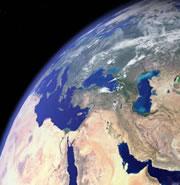 Getting taxonomists from around the world to moderate a wiki-style database may be easier said than done.NASA
Getting taxonomists from around the world to moderate a wiki-style database may be easier said than done.NASAAn effort to collate information on nearly 2 million species of animals, plants and other forms of life into a single online database launches today.
Over the next 10 years, the 'Encyclopedia of Life' project will create web pages for all 1.8 million species currently named. It plans to provide multimedia information for many of them, including video, sound, images, graphics and text.
Myriad initiatives to catalogue biodiversity on the Web are already underway all over the world. But "this is the next step, where you give encyclopaedic information rather than just catalogue that a species exists," says Frank Bisby, co-chair of another project called the Catalogue of Life. This catalogue reached the impressive milestone of documenting the common and Latin names of 1 million species in March.
The Smithsonian Institution, Field Museum, Harvard University, Marine Biological Laboratory, Biodiversity Heritage Library and the Missouri Botanical Garden have kick-started the project. And the Atlas of Living Australia, a web-based encyclopaedia of Australia's biodiversity, is poised to come on board.
Edward O. Wilson, professor emeritus of Harvard University, is one of the godfathers of the project. He predicts that compiling the world's information on biodiversity and making it readily accessible will reveal new phenomena. "The encyclopaedia will be our 'macroscope', comparable to the microscope used by biology until now," he says.
Filling empty pages
The encyclopaedia project hopes to draw on efforts going on around the world, including the Catalogue of Life. But getting taxonomists from a range of universities and institutes involved to moderate a wiki-style database may be easier said than done, notes Rod Page, a taxonomist at the University of Glasgow, UK, who runs his own database called iSpecies and has been loosely involved in the encyclopaedia project.
Page's wariness stems from observing the failure of many similar initiatives, which have ultimately lacked the resources to fill promised web pages. "This isn't the first time people have said: 'this time we've got lots of money to document all species online'," he says.
It's not yet clear how the Encyclopedia of Life will be sustained in the long term. Bisby says that for the Catalogue of Life, at least $2-4 per species per year is needed to maintain each page in the database. But that cost is likely to be significantly higher for the encyclopaedia, which plans to offer a much richer range of multimedia information.
"For electronic material in general, how you sustain it forever is a huge issue," says Page.
ADVERTISEMENT
The MacArthur Foundation is investing a start-up fund of $10 million for the project, with $50 million in total promised. Another $2.5 million will come from the Alfred P. Sloan Foundation.
The encyclopaedia team's hope is to be able to link users to a mass of quality-controlled biological knowledge, including specialized resources for taxonomists, molecular biologists, geneticists, physiologists and conservationists. This should aid scientists across disciplines. For example, data on habitat range would allow conservationists to more easily model the effects of climate change on a particular species, says Bisby.
"If it's done well it could be fabulous," says Page.
Visit our oflife_launched.html">newsblog to read and post comments about this story.
